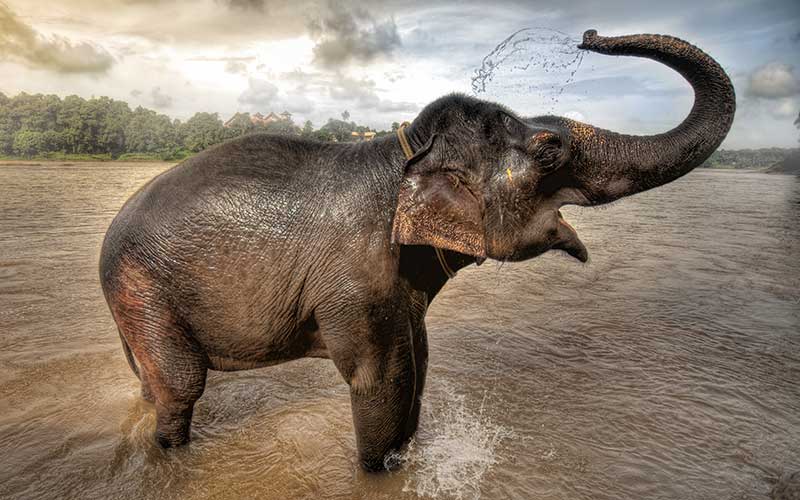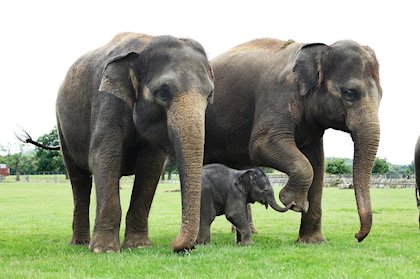Unfortunately, the Asian elephant is a species that is in danger of extinction, this is because there is almost no natural habitat for it, however, work is being done to solve this problem and give it a better life. By reading this brief summary you will be able to learn about it, which represents one of the two species of elephants that currently exist on the planet.

This is an animal that is quite large, usually has a height ranging from 2 to 2.7 meters, its weight ranges between 2 and 5 tons. The largest Asian elephant has reached about 3.2 meters in height, it is worth noting that the difference between Asian elephant and African elephant is the shape of the skull of both. The Asian has shorter ears than the African and the head is bumpy, also its back is sloping downwards.
Features
The Asian elephant has the following characteristics:
- The males have their two tusks like the African elephant, but the female does not have these. These fangs are used to demolish trees and for their battles.
- Its skin is totally dry and quite thick, there is very little fur that this animal develops.
- Its trunk is made up of approximately 100 thousand muscles, this is one of the most important parts in the body of any elephant.
- The weight of the male is approximately 5 tons while the female weighs a little less.
- The height of the male is higher than that of the female, while the male measures 3.2 meters, the female measures about 3 meters.
The Asian elephant and its diet
This animal to feed itself completely eats a lot. Their diet is based on vegetables, bushes, leaves, among others. The amount of food what does the elephant eat in one day, by weight it is about 135kg of pure food. Whether in the morning, afternoon or night, the Asian elephant can feed, it likes to be near places where there is water and can consume approximately 140 liters per day. The White Tiger it is an animal that is also found in Asia and its information may be of interest to you.
The habitat of this elephant
The natural habitat of this is in the Asian area, hence the name of Asian elephant. Countries like Bangladesh, Sri Lanka and India are where this is located, thanks to certain changes that have been happening in its environment these have been seen in places like Nepal and Indochina and some parts of Indonesia. A worldwide calculation has been made and the estimate of its existence is less than 50 thousand elephants, well below the African elephant that is estimated to exist 400 thousand.
There is another number of Asian elephants located in the South of the Himalayas and also other numbers quite close to the Yangtze River. These have as their habitat areas of low vegetation and also thickets.
How is their behavior?
The first thing to note is that the Asian elephant is quite intelligent. It tends to form too strong ties with other elephants, it migrates because its food tends to be scarce at times due to the amount it eats. As long as its habitat is maintained, it will be in it and will give the best care to its young, it is capable of expressing certain emotions, as well as it can last a long time in interactions and games with other people.
the must
The Asian elephant goes through a process of change called “must”. It is something that only happens to the male and not to all, science has not been able to solve this and it is that they begin to suffer from greater aggressiveness, also increasing their sexual appetite. The female tends to avoid the male that has this and the consequence is a tense environment, when this elephant has secretions on his cheeks it is that he is going through the “Must”, Since there is no scientific cure, they are left tied up for a while.
The relationship of man with the Asian elephant
This has served to make some activities much easier for man, among them those of greater strength such as loading material to build, transporting people and also in wars it has been used for the defense of warriors. In many cultures the Gods have been illustrated with certain forms that are characteristic of elephants.
Actually, the Asian elephant does not have a sacred meaning, which is unfortunate for many people. On the contrary, they have been hunted for years for their ivory and have also been used to work in circuses, which many people do not support. This is a species that could become extinct since its habitat is being destroyed more and more every day.
Your reproductive process
The process of reproduction of the Asian elephant occurs at any time in which it can do this act, it is through sex and for this male and female release some scents that serve to attract the other. The female will be at her sexual maturity at the age of 14 at the earliest, but many do not perform this act until they are about 25 years old. The male mates from the age of 35 to 50 years and this is because they compete with others to have the right to this.
If you want to know about a small animal that you might be interested in taming, the Chipmunk It is a good option in these cases.
its conservation
As is well known, it is illegal to hunt the Asian elephant, yet this hunt continues to take place illegally in many places. It may be to extract its ivory tusks or also for sport, something that is not approved by many people and associations for its protection, this elephant has a problem in its genes and this is because in most cases the female does not mate with the fittest elephant.
It is very important that the world becomes aware so that it can be preserved and does not become extinct, but unfortunately there are not many people interested in helping with this issue which, if it continues like this, will end up ending the existence of the Asian elephant in a few years. .

